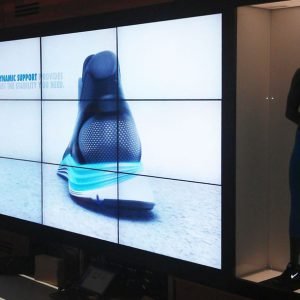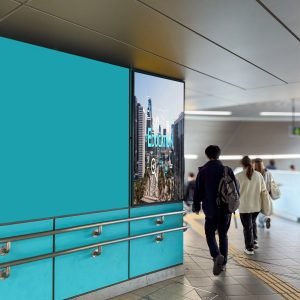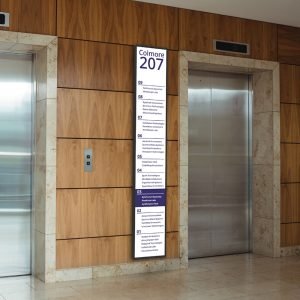Is your business struggling to guide visitors efficiently through large spaces? Digital wayfinding signage can be the solution you need! Being relevant and universal in its design, it contributes effectively to corporate navigation and improves the visitor experience.
When a visitor is getting to some business building and it is rather large, for instance it may be a corporate office, retail centre, hospital or university it is very important to observe proper way finding. In this guide, you’ll learn the basics of digital wayfinding signage, why it’s important, and how to get started with a successful plan.
Understanding the Importance of Digital Wayfinding Signage
Getting around vast areas is not easy, and wrong signs give their users a bad experience and a wrong perception of your company. Interactive, real-time directional information provided by digital wayfinding addressing these challenges directs the visitors without stress. Not merely a signpost pointing the way to attractions or services, it is also a positive means to improve visitor traffic and increase the profile of the brand.
Trend of Digital Wayfinding Signage
Digital wayfinding has evolved significantly in recent years, with many businesses adopting it to keep up with technological advancements and user expectations. Technological interaction methods such as touch screen kiosks, maps, and clients’ tailored content is the new generation of dynamic and innovative signs. This is because through the use of the digital signage information can be presented in a format that changes with the flow of the traffic making it easier for the visitors to comprehend as well as to interact with the space.
Benefits of Digital Wayfinding Signs for Your Business
Digital wayfinding offers numerous advantages over traditional signage, making it a smart investment for large spaces. Here are the top benefits:
Provide Flexibility to Update Content Instantly
Digital wayfinding signage is flexible. Unlike static signs that must be renewed manually, digital displays allow you to update your content instantaneously. This may come in handy in environments where changes in layouts happen frequently or there are daily events and schedules that need updating.
Enhanced Brand Identity and Visual Impact
Digital signage does not serve only a functional purpose. It also serves to help brand the property in such a way that can convey cohesiveness and professionalism. In using your brand colours, typefaces, and logos in your wayfinding signage, your brand is able to come together cohesively and professionally. Digital displays also allow for high-resolution graphics and animations, so you may design visually appealing signage that really pops.
Cost-Effective in the Long Run
Even though the installation of digital signage will seem to be capital-intensive upfront, it really proves cost-effective in the long run. You are unlikely to need to print a new sign for an update, thus you save on materials and labour. In addition, digital wayfinding signage can perform several tasks: showing advertisements, announcements, or emergency information-to get the most use possible from your dollars.
Enhanced Visitor Interaction
Digital wayfinding signage is not just static signs. Interactive components such as touchscreens, QR codes, and mobile integration can engage visitors at a deeper level. In fact, such an approach allows them to discover your space by themselves; hence, it is more personal and fulfilling. You, therefore, make it easier for them to find what they want, and visitor satisfaction and loyalty are increased.
How to Plan a Wayfinding Strategy for Complex Environments?
To plan an effective wayfinding strategy, you need to have a good understanding of your space as well as the needs of your visitor. Here’s a step-by-step approach for planning your wayfinding strategy in large and complex environments:
Step 1: Analyse the Space: Mark areas of high-traffic flow, principal attractions, and areas of confusion
Step 2: Understand User Flow: Examine the way visitors flow through the space, identifying key decision points.
Step 3: Define Goals: Identify what you want to accomplish with the signage, either by making the museum easier to navigate, reducing crowding, or stimulating people to visit certain parts of the museum.
Step 4: Choose Correct Sign Types: Depending on your goals, you must decide between a mix of static signs and digital signs so that your visitors are directed appropriately.
Step 5: Test and Refine: Installing your wayfinding system and gathering comments so that you can fine-tune your approach. Testing helps ensure that your signs are intuitive and meet the expectations of visitors.
Digital way-finding signs will be instituted with the proper planning and strategic placement and eliminate confusion and make the space both ordered and enjoyable to visitors.
What are the Key Principles of Designing Effective Wayfinding Signage?
It is therefore important to note that designing an effective way of finding signs requires three aspects namely; clarity, simplicity and consistency. Here are the key principles to keep in mind:
- Keep It Simple: Someplace overloading viewers with too much information can be cumbersome to the extent of losing them completely.
- Be Consistent: Make sure that the signs all use the same colours, fonts, and symbols to enhance everyone’s comprehension.
- Prioritise Key Information: Ensure that things like the floor number, directional arrows, and the most iconic structures in the building should be clearly seen.
- Use Universal Symbols: If icons are placed they should be in a universally understood format so that individuals from different backgrounds can easily locate them.
- Incorporate Interactive Elements: Introducing interactivity attaches the value of touch when searching for information and enables the visitors to modify the information depending on their needs.
By the above principles, you are guaranteed that the wayfinding signage that you create on your facility is easy to read, attractive to the eyes and functional in directing people.
Conclusion
Digital wayfinding signs are very useful to any company that needs to enhance the flow in large spaces. At Signworld Group we know just how valuable it is to ensure that your signage not only serves its purpose but is aesthetically fit and branded.
If you are ready to make a change and improve the look and effectiveness of your digital wayfinding systems, get in touch with Signworld Group now. Each of our clients will subsequently be assigned a dedicated team of experts to assist in determining the most appropriate customised solution for your business and how your business will be distinct from others in the market.















